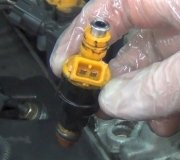Dandy. On all cars except for Chrysler products, the mass air flow sensor has the biggest say in fuel metering calculations. He sits in the fresh air tube between the air filter box and the throttle body. There can't be any loose hose clamps, cuts, or other leaks in that tube because if any air sneaks in that doesn't go through that sensor, it won't get measured, and the computer won't calculate the correct amount of fuel to go with it. Those calculations are mildly fine tuned based on readings from many of the other sensors.
You have to keep the fuel / air mixture ratio perfect for best power and least emissions. If you do anything to add fuel, and the engine runs better or seems to have more power, that is proof something was wrong before, and that should be addressed.
There is something I'll let you look at, but don't waste your money on it. That's a cold air intake system. People out to impress their friends install these systems but they don't really understand why they're getting ripped off. The advertising will tell you that if you cool the incoming air, it will condense so you can squeeze more of it into the cylinders. That additional air will be going through the mass air flow sensor where it gets measured, and the computer will add the right amount of fuel to go with it. So guess what? You have more air and more fuel, and the engine goes faster. The rest of us do the same thing by pressing further on the accelerator pedal. The only time this might have an advantage is at wide-open-throttle. Normally you are limited by the size of the cylinders as to how much air they can hold and how much fuel goes with it. With a little extra cold air, you may get a little extra fuel, but the computer knows what "normal" is at wide-open-throttle and may compensate by giving you less than expected. After all, how long do you drive at wide-open-throttle?
The next thing that most people don't understand is liquid gasoline doesn't burn. In fact, I've watched demonstrations where a tray with liquid gas will put out a lit match that's thrown into it. Gasoline has to be a vapor to burn. It's the job of the intake system to warm the fuel to help the fuel vaporize quickly before it goes into the cylinders. Why would you want to defeat that by cooling the incoming air? When any fuel fails to vaporize, it goes out the tail pipe, wasted, without making any power. That can show up to the oxygen sensor as a lean condition. The computer will respond by adding more fuel, but that just gets you back to the correct mixture, plus the unburned gas being wasted.
You will also have an intake air temperature sensor. That can go by various names, but it tells the computer the temperature of the incoming air. If it's real cold, less fuel, by percentage, is going to vaporize, so it increases the amount to insure enough vaporizes for the engine to run right. We used to use a choke for that when we had carburetors. You'll still see chokes on lawn mower engines, but they don't make the engines develop any more power once they're warmed up, do they?
If I haven't convinced you to run from these systems yet, consider that where I'm freezing my behind off in winter, cars don't have any more power with all that really cold air.
Next, since this is somewhat new to you, please do not think about altering the ride height of your car. As a suspension and alignment specialist, this really aggravates me. I have a really long-winded canned reply that I can share if you want me to, but for now, let me leave it at I have four early '70's Dodge Challenger muscle cars, and I've had a few street cars that I raced on oval tracks years ago. Every one of them was at the exact height specifications. If you're considering damaging your car by lowering it, give me the chance first to convince you to rethink that idea.
There's one more thing to ponder on that likely hasn't occurred to you yet. Marketing of cars is an extremely competitive business. If a manufacturer can legally advertise one extra cubic foot of space, one extra inch of leg room, one more cup holder, or one more horsepower than the other guys, you can be sure they're going to do it. They could produce a car with more power, but it always comes with a trade-off. More power obviously gets you lower fuel mileage, but it also affects idle quality, emissions, and other characteristics. They could build a lowered car or a raised truck. They can see there's a market for those vehicles, but they know it can't be done without compromising safety and the threat of lawsuits. There is no chance you, I, or anyone else other than professional race teams are going to build what the manufacturers can't build with all their development teams and resources. You have a rather nice car now so don't mess it up. Just enjoy it.
Tuesday, November 17th, 2015 AT 11:21 PM


